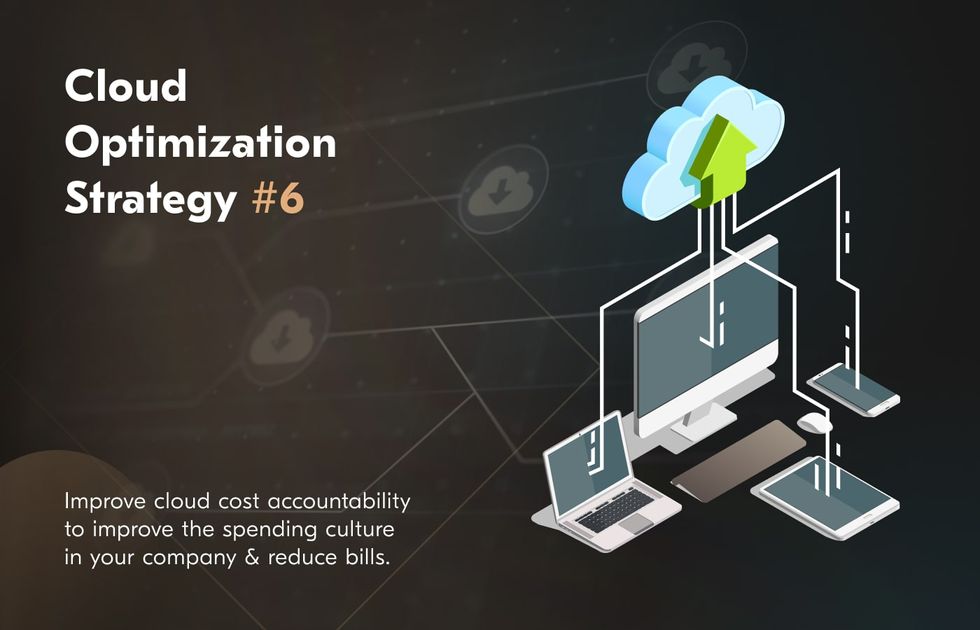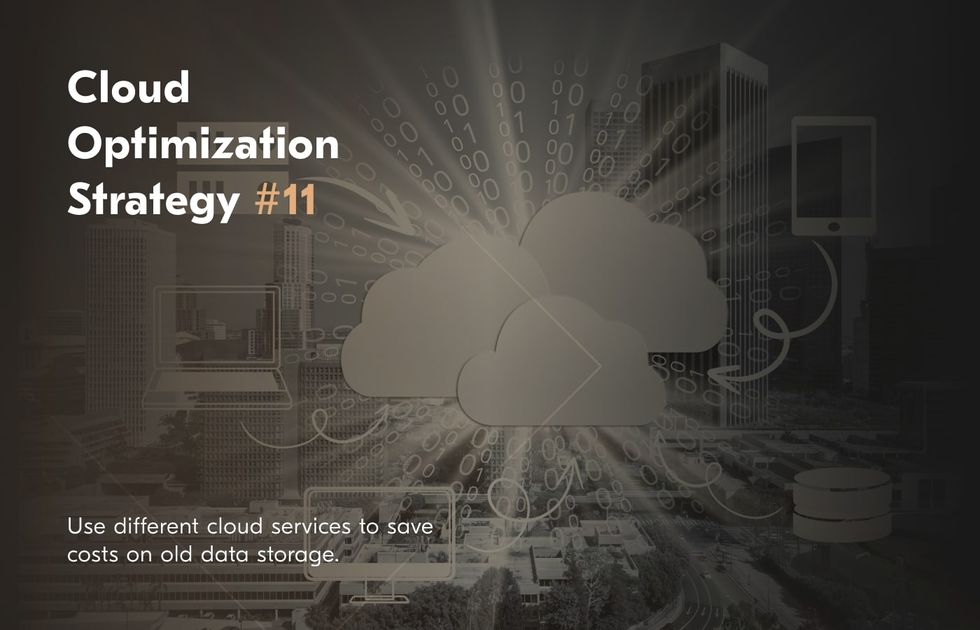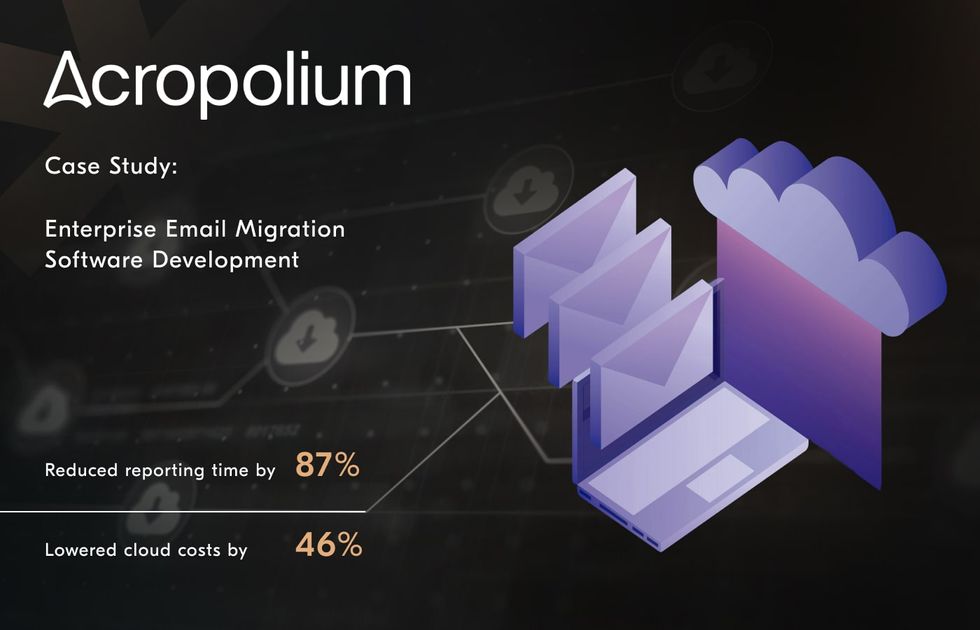
Key Takeaways
55% of enterprises review their cloud expenses at least once a month, emphasizing proactive cost control.
The global cloud cost management market is projected to reach $25.38 billion by 2032, reflecting increasing demand for optimization solutions.
Businesses waste over 24% of their public cloud spending, highlighting the need for cost optimization strategies.
Acropolium helped a client optimize cloud costs by 46% through SSO implementation while reducing reporting time by 87%.
The price of cloud computing can skyrocket as you use more storage and resources. Most enterprises don’t know how to reduce these expenses because of the complex provider bills and analytics. Thankfully, effective cloud cost optimization and financial management practices can help you avoid chaos.
In fact, 55% of enterprises review their cloud expenses at least once a month to keep costs under control. At the same time, more and more companies are focusing on automation, with rating its importance at 7.29 out of 10.
This article will tell you how to adapt the right cost management framework for private, public, and hybrid cloud services. Read until the end to discover 13 strategies that can help you use your resources more efficiently. More than that, you will find real-life examples of how we helped our clients reduce their cloud costs thanks to Acropolium’s 13-year experience working with cloud technologies.
What is Cloud Cost Optimization?

Cloud cost optimization helps businesses get the best value from their cloud investments by ensuring the right resources are used for each application or workload. It’s all about finding the right balance between performance, cost, security, and compliance to meet an organization’s needs.
Since every workload has unique requirements that change over time, optimizing costs means setting clear performance benchmarks based on real data and industry knowledge. The goal is to cut unnecessary expenses while keeping everything running smoothly, especially after SaaS migration.
Cloud cost optimization is an ongoing process that adapts to evolving application needs, fluctuating cloud pricing, and new service options. Given the complexity of cloud environments, it relies on detailed analytics, automation, and smart tools to make data-driven decisions.
Moreover, this complexity rises if you’re about to integrate cloud services into your legacy system. That’s why the need for optimizing cloud costs is always relevant, with the global cloud cost management market expected to grow to $25.38 billion in 2032.
Cloud Cost Optimization Benefits For Businesses

Companies should recognize cloud spending optimization as an integral part of their workflow. Nearly all legacy workloads that migrated to the public cloud infrastructures require a proper framework to become cost-effective.
Now, why is it important to focus on the efficient use of cloud resources? Let’s start with the obvious advantage.
Reduced Expenses
Companies are increasing their cloud spendings, yet only a few are serious about cost analytics. According to the State of Cloud Optimization Report, 46% of enterprises have a dedicated cloud optimization team. At the same time, the 2024 Flexera Cloud Report reveals that business leaders estimate wasting more than 24% of their public cloud spending.
What’s the bottom line? Cloud cost reduction should be one of your top priorities. With the right strategies and tools, companies can rightsize their resources to eliminate waste spendings and reduce IT budgets.
Improved Visibility
Cloud cost optimization tools can give companies an in-depth understanding of what happens in their IT environment (including over-provisioned and underutilized resources). Additionally, optimization can help companies gain a cohesive view of every business unit, product, and cost center.
The optimization framework allows companies to measure how their teams use resources. You can then use this data to allocate budget between departments, build strategic initiatives, and help employees understand how to reduce cloud costs.
Stronger Governance & Compliance
Some cost management practices can do more harm than good. For example, blindly turning off unused instances and cloud-based applications can disrupt your staff’s workflow. This will force them to use independent software (shadow IT) that can compromise your cybersecurity.
But effective cloud cost management won’t frustrate your employees or force them to use unapproved tools. Consequently, cost optimization can reduce the risks of data breaches.
AI-driven Cost Optimization & Automation
AI-powered solutions take the guesswork out of managing cloud costs. They automatically scale resources, prevent overprovisioning, and optimize workloads in real time — helping businesses save money without extra effort.
Such cloud cost optimization tools analyze usage patterns, predict future needs, and make intelligent adjustments so that you only pay for what they actually use. Automation reduces manual workload, improves efficiency, and keeps cloud spending under control.
Multi-cloud & Hybrid Cost Control
Using multiple cloud providers or a mix of cloud and on-premises systems can get expensive and complicated, notably during software reengineering. Cost optimization tools ensure seamless cost efficiency across AWS, Azure, and GCP by providing a clear view of spending across all platforms.
With centralized cost management, you can compare pricing, allocate resources effectively, and avoid vendor lock-in.
Sustainable & Green Cloud Computing
Cutting down on wasted resources and optimizing cloud cost doesn’t just save money — it’s also better for the environment. By optimizing workloads and using energy-efficient computing, businesses can lower costs and reduce their carbon footprint without sacrificing performance.
Cloud providers offer green computing options, such as renewable energy-powered data centers and carbon tracking tools, allowing businesses to make eco-friendly choices while maintaining scalability and reliability.
13 Cloud Cost Optimization Strategies

Effective resource management goes beyond turning off idle resources. In some cases, traditional solutions can limit your productivity, which will only add to your expenses.
Enterprises need to establish a strategic approach to cost management within their resource planning strategies. To achieve this, your organization should gain a comprehensive view of stakeholders, cost centers, applications, and deployed resources.
Now, let’s discuss what strategies are the most effective for cost optimization in cloud computing.
#1. Decide on the Stakeholders
Cloud cost optimization requires engaging the key stakeholders. This includes:
Product owners. Owners can help your teams understand the purpose and business value of each application.
Managers. They define business KPIs for each application in terms of performance, availability, and expected usage.
DevOps teams. These teams are responsible for managing resources and keeping costs under control.
Finance department. The finance dept approves budgets and resource allocations, plus it implements chargeback and showback models.
Cloud custodians. Some companies create CCOE teams that oversee cloud cost management and provide consultations to other parties.
These stakeholders should collaborate to determine critical metrics and governance policies for managing cost optimization practices.
#2. Choose a Pricing Model
Cloud vendors usually offer two charging models. In the allocation-based model, providers charge for the provided services regardless of usage. Alternatively, providers can follow the consumption-based model to bill companies based on the resources they’ve utilized.
Most organizations will benefit from the consumption-based model. However, you should design your architecture based on the expected usage to minimize spendings.
How do you predict your resource usage and choose the right model?
Service availability. Providers can offer cheaper plans in exchange for lower uptime.
Backup. The provider can charge more because it copies your data to multiple locations.
Embedded software. You need to consider software license fees because they can comprise a significant part of the operating costs.
Tenancy. Multi-tenant infrastructure is usually more profitable for startups and small businesses, while single-tenant environments provide better uptime and secure software development.
Performance target. CPUs and block storage volumes with higher IOPS will deliver better performance, although at a higher price.
You should also learn about the available discount models. For example, the provider can offer negotiated and programmatic discounts for higher upfront payment or commitment to use their service for an extended time.
#3. Tag Resources
Tagging means attributing resources with metadata that will appear next to each line item in the provider’s bill. Organizations can customize their tags and apply them to instances and resources on different projects or subscriptions. On top of that, labels don’t create any implications or dependencies on the resources.
We recommend creating a unified dictionary and naming conventions for your tags. This will help you promote these tagging practices during the company’s workshops and meetings.
Modern cloud-native tagging services and AI-powered tagging systems can automate this process, ensuring consistency and reducing manual effort. These intelligent tools analyze usage patterns and suggest optimized tags for better cost allocation.
#4. Allocate Costs For Shared Resources
If you’re using a consumption-based cloud billing model, you’ll need to distribute costs between all parties accurately. Larger enterprises can encounter difficulties during allocation management if multiple departments share platforms.
For example, an entire organization can use only one network connection for accessing cloud services or train from a single e-learning app.
Still, you can determine how to split costs for these resources by tagging nested virtual resources instead of the primary services. Alternatively, you can create multiple copies of a single platform on smaller resource sets, label them, and distribute these sets between departments.
#5. Select an Appropriate Governance Model
Companies need to choose between two governance modes:
In-the-way governance, where centralized IT collects and manages all requests for cloud services. The cloud interface is hidden from other departments, which eliminates any autonomy.
On-the-side governance, where departments and specialists can control resource allocation via a native cloud interface according to the governance policies.
The on-the-side approach is proven to be much more scalable for cloud computing environments. Your employees won’t have to wait for the central department to approve every minor change request, greatly improving their productivity.
#6. Improve Accountability

Сompanies can create dashboards and report generation tools to help managers analyze:
Regular trending patterns
Differences between forecasted and actual spendings
The most and the least spending departments, accounts, and applications
How changes impact performance
You can use these tools to allocate spendings between your departments and cost centers with chargebacks and showbacks. Doing so will improve the spending culture across your organization, which is effective for reducing cloud bills.
#7. Set up Alerts on Anomalies
Monitoring and controlling cloud spend can be overwhelming, considering hundreds of metrics. You can free up your team’s time by introducing automation tools that will notify you about the deviations from expected performance (normal states).
Imagine that one of your departments spends almost half of its monthly resources during the first week. Well, correctly configured alerts can help you take corrective actions immediately instead of waiting for the provider’s bill.
#8. Dispose of Unused Resources
Eliminating unused instances is one of the most cost-effective cloud cost optimization strategies. But before considering what to dispose of, organizations need to define rules for the “unused” resources based on several utilization parameters:
RAM & CPU usage patterns
Network bandwidth
Login sessions (Secure Shell and Remote Desktop Protocol)
After you define policies based on these metrics, we recommend looking for the following instances:
Compute instances. Idle compute instances are common in testing environments and have extremely low usage metrics.
Storage volumes. You should consider deleting or snapshotting unattached volumes that haven’t been used for a long time.
Old snapshots. Regularly monitor snapshots and delete those that become inaccessible after long idle periods.
IP addresses. Some companies preserve IPs for future use, but you should consider releasing them to the provider if they haven’t been associated with any resources for too long.
PaaS resources. Application PaaS are mapped to underlying compute resources, which is why you should monitor them and decommission those you don’t need.
We recommend setting individual disposal policies for critical resource types if you’re using an on-the-side governance model.
Note that AI-driven monitoring tools can further enhance efficiency by automatically detecting underutilized resources and deactivating them based on predefined policies. This way, you can analyze live usage trends and trigger automated decommissioning, reducing manual oversight.
#9. Schedule Application Instances
Development and test workloads typically remain idle only for specific hours or days. You can develop a scheduling policy and power them down to optimize cloud costs.
Your scheduling policy needs to match the expected usage patterns based on historical data. Alternatively, you can configure the system to turn these instances off when the usage is low.
#10. Rightsize Allocation-based Services
Rightsizing means adjusting cloud resources according to the workload demand. When done right, rightsizing is the most effective optimization strategy for public and hybrid clouds.
Here are the most valuable practices you can implement:
Start rightsizing with the resources that have the highest costs and the lowest demand
Divide instances into smaller resource sets and distribute the workload between them
Consider CPU, RAM, network and storage bandwidth before sizing instances down
Introduce continuous rightsizing (downsize and measure performance in multiple steps to avoid performance drops)
Rightsizing involves the ongoing control of the entire cloud infrastructure. In addition to cloud cost reduction, it can improve the general performance of your apps.
With AI/ML tools for predictive rightsizing your resources will automatically adjust to fluctuating workloads. Such solutions analyze historical data and forecast demand, helping organizations maintain optimal performance while minimizing waste.
#11. Use Different Cloud Services

The multi-cloud approach is one of the most common strategies adopted by 89% of enterprises. Why?
Not all of your data requires services with a 99.99% uptime and low latency. So consider using cheaper cloud services to store old data like snapshots and idle applications.
Additionally, some providers offer reasonably priced managed services for file storage. For example, the Amazon S3 Intelligent-Tiering S3 class can automatically redistribute some of your instances to cheaper storage based on access frequency.
#12. Introduce Horizontal Autoscaling
Companies can configure policies that automatically scale the number of parallel application instances based on the load. For example, you can set autoscaling to be triggered by:
Infrastructure performance (CPU load, network latency, available memory)
Middleware components (queue length and database load)
Schedule-based scaling (expected resource utilization peaks)
Application-specific metrics (open chat sessions, active video conference members, loaded online shopping carts)
Horizontal autoscaling usually includes limits for available resources, such as a maximum number of provided instances.
#13. Utilize Cloud Cost Management Platforms
Most public cloud services offer native software for cost optimization and management. For instance, AWS and Microsoft Azure have tools that gather valuable cost metrics. However, native tools often lack functionality and have limited usefulness outside their cloud platforms.
You should carefully assess each third-party provider before buying the tool. After all, the market is full of similar third-party apps, many of which don’t even come close to the default AWS, Azure, and Google analytics tools.
That’s why it’s an excellent idea to hire an experienced IT company or outsourcing agency — for the most effective solutions for cloud governance and cost management.
Acropolium’s Expertise in Cloud Optimization
Acropolium is an experienced technology partner with decades of expertise in cloud computing. Our team carried out over 93 successful cloud migrations and reduced cloud bills for many logistics and transportation, healthcare, and HoReCa companies.
Previously, we created a flexible SaaS communication platform for an enterprise medical vendor. Our in-depth audit identified that the client’s storage had access issues and was generating excessive administrative expenses.
Now, we’d like to deeper dive into one of our client’s success cases that showcase our approach.
Enterprise Email Migration Software Development: Case Study
Another of our projects includes proprietary enterprise email migration software for an international technology company. Our solution had to transfer a large amount of data between different cloud services and on-premise servers.
Solution

The client prioritized rapid implementation, leading Acropolium to analyze bounded contexts (Domain-Driven Design) and assemble expert teams. We delivered:
Enterprise email migration software for secure, fast transfers of Exchange Mailboxes and Archives to cloud or on-premises servers.
Seamless data migration with tenant-to-tenant transfers, consolidation, and relocation.
A Veritas-partnered replication tool ensuring reliable backup and migration.
Results
A universal access library reduced reporting time by 87%.
Implementing SSO streamlined data storage, optimizing cloud costs by 46%.
The Bottom Line
Effective cloud cost reduction is much more than merely disposing of unused resources to control prices. Instead, companies should find the balance between expenses and performance to reduce cloud bills without sacrificing productivity. To achieve that, you need to introduce appropriate practices, apply iterative monitoring, and ensure tight collaboration between stakeholders.
Acropolium can assess your current cloud infrastructure to find cost leaks, anomalies in usage patterns, and performance gaps. Our cloud consulting can help you rightsize your resources while improving your efficiency and security on a subscription basis with your budget in mind. How? Contact us to find out.











![ᐉ How to Migrate Application to the Cloud [A Practical To-Do List]](/img/articles/migrate-your-software-to-the-cloud/img01.jpg)